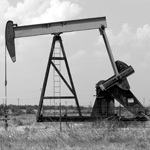
Principles of Sustainability
Chapter 6 - Energy Sustainability
Part 5 - Fossil Fuels: Oil
 Oil has been a key commodity in our human civilization for over 100 years, providing energy, jobs, materials, and adding to our quality of life. Pollution from oil in the production, distribution, and consumption arenas is significant, and the contribution of oil combustion to climate change is real. Proved pumpable reserves are limited, and exploitation of abundant tar sands and oil shale comes at significant environmental and economic costs. Enhanced oil recovery (EOR) techniques for mature oil reserves, and processing oil sands and shales will be expensive, driving up the cost basis of petroleum products. The Reserves-To-Production Ratio, a useful industry metric comparing known "proved reserves" to world oil consumption rate, is currently at 46 years of supply. Oil consumption rates and global population growth are increasing. Peak oil is a reality of our future, and the resource cannot be sustained. It is a harsh reality of nature - that born today - the baby of "Drill, Baby, Drill" may outlive the petroleum era.
Oil has been a key commodity in our human civilization for over 100 years, providing energy, jobs, materials, and adding to our quality of life. Pollution from oil in the production, distribution, and consumption arenas is significant, and the contribution of oil combustion to climate change is real. Proved pumpable reserves are limited, and exploitation of abundant tar sands and oil shale comes at significant environmental and economic costs. Enhanced oil recovery (EOR) techniques for mature oil reserves, and processing oil sands and shales will be expensive, driving up the cost basis of petroleum products. The Reserves-To-Production Ratio, a useful industry metric comparing known "proved reserves" to world oil consumption rate, is currently at 46 years of supply. Oil consumption rates and global population growth are increasing. Peak oil is a reality of our future, and the resource cannot be sustained. It is a harsh reality of nature - that born today - the baby of "Drill, Baby, Drill" may outlive the petroleum era.
In 2009, The Chief Economist at the International Energy Agency, Dr. Fatih Birol said:
“The public and many governments appeared to be oblivious to the fact that the oil on which modern civilization depends is running out far faster than previously predicted, and that global production is likely to peak in about 10 years – at least a decade earlier than most governments had estimated.”
Keywords
- Petroleum
- Peak oil
- Hubbert curve
- Reserves-to-production ratio (RPR)
- Primary recovery
- Secondary recovery
- Tertiary or Enhanced oil recovery (EOR)
- Proved oil reserves
- Tar sands
- Oil shale
- Vertical drilling
- Directional drilling
- Horizontal drilling
- Offshore drilling
- Drilling barge
- Jackup rig
- Semi-submersible oil rig
- Drill ships
- Oil spill
- Oil sands
- Climate change
Suggested Reading
- Oil's tipping point has passed. James Murray and David King (2012) Nature. Vol 481. pp 434-435.
- Oil: Crude and Petroleum Products. Refining Crude Oil Where Our Oil Comes From Imports and Exports Offshore Oil and Gas Use of Oil Prices and Outlook Oil and the Environment U.S. Energy Information Administration. U.S. Department of Energy.
- Statistical Review of World Energy - Oil. BP
- Oil. Federal Energy Regulatory Commission.
